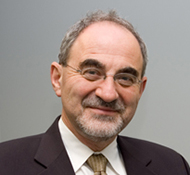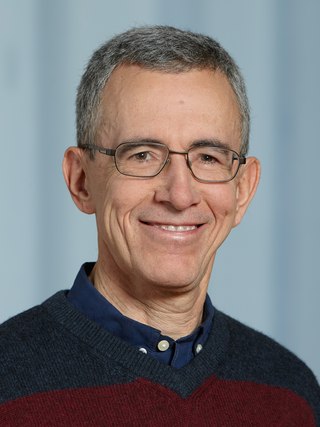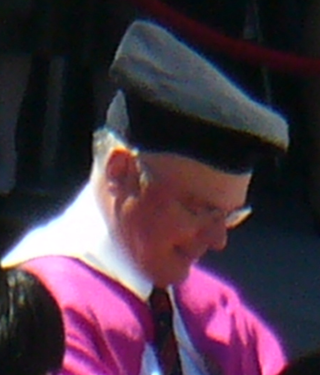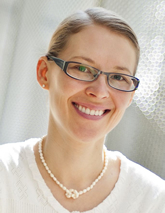Related Research Articles

Photonics is a branch of optics that involves the application of generation, detection, and manipulation of light in the form of photons through emission, transmission, modulation, signal processing, switching, amplification, and sensing. Photonics is closely related to quantum electronics, where quantum electronics deals with the theoretical part of it while photonics deal with its engineering applications. Though covering all light's technical applications over the whole spectrum, most photonic applications are in the range of visible and near-infrared light. The term photonics developed as an outgrowth of the first practical semiconductor light emitters invented in the early 1960s and optical fibers developed in the 1970s.

Eli Yablonovitch is an American physicist and engineer who, along with Sajeev John, founded the field of photonic crystals in 1987. He and his team were the first to create a 3-dimensional structure that exhibited a full photonic bandgap, which has been named Yablonovite. In addition to pioneering photonic crystals, he was the first to recognize that a strained quantum-well laser has a significantly reduced threshold current compared to its unstrained counterpart. This is now employed in the majority of semiconductor lasers fabricated throughout the world. His seminal paper reporting inhibited spontaneous emission in photonic crystals is among the most highly cited papers in physics and engineering.
Federico Capasso is an applied physicist and is one of the inventors of the quantum cascade laser during his work at Bell Laboratories. He is currently on the faculty of Harvard University.
Bjarne Tromborg is a Danish physicist, best known for his work in particle physics and photonics.
Xi-Cheng Zhang is a Chinese-born American physicist, currently serving as the Parker Givens Chair of Optics at the University of Rochester, and the director of the Institute of Optics. He is also the Chairman of the Board and President of Zomega Terahertz Corporation.

Ataç İmamoğlu is a Turkish-Swiss physicist working on quantum optics and quantum computation. His academic interests are quantum optics, semiconductor physics, and nonlinear optics.
The IEEE Photonics Society, formerly the IEEE Lasers and Electro-Optics Society (LEOS), is a society of the Institute of Electrical and Electronics Engineers (IEEE), focused on the scientific and engineering knowledge about the field of quantum electronics. In the hierarchy of IEEE, the Photonics Society is one of the close to 40 technical societies organized under the IEEE Technical Activities Board.

Anthony Michael Johnson is an American experimental physicist, a professor of physics, and a professor of computer science and electrical engineering at the University of Maryland, Baltimore County (UMBC). He is the director of the Center for Advanced Studies in Photonics Research (CASPR), also situated on campus at UMBC. Since his election to the 2002 term as president of the Optical Society, formerly the Optical Society of America, Johnson has the distinction of being the first and only African-American president to date. Johnson's research interests include the ultrafast photophysics and nonlinear optical properties of bulk, nanostructured, and quantum well semiconductor structures, ultrashort pulse propagation in fibers and high-speed lightwave systems. His research has helped to better understand processes that occur in ultrafast time frames of 1 quadrillionth of a second. Ultrashort pulses of light have been used to address technical and logistical challenges in medicine, telecommunications, homeland security, and have many other applications that enhance contemporary life.

Amnon Yariv is an Israeli-American professor of applied physics and electrical engineering at Caltech, known for innovations in optoelectronics. Yariv obtained his B.S., M.S. and PhD. in electrical engineering from University of California, Berkeley in 1954, 1956 and 1958, respectively.

David A. B. Miller is the W. M. Keck Foundation Professor of Electrical Engineering at Stanford University, where he is also a professor of Applied Physics by courtesy. His research interests include the use of optics in switching, interconnection, communications, computing, and sensing systems, physics and applications of quantum well optics and optoelectronics, and fundamental features and limits for optics and nanophotonics in communications and information processing.
Shun Lien Chuang was a Taiwanese-American electrical engineer, optical engineer, and physicist. He was a Fellow of the IEEE, OSA, APS and JSPS, and professor at the University of Illinois at Urbana-Champaign.
John Michael Dallesasse is a Professor of Electrical and Computer Engineering at the University of Illinois at Urbana–Champaign where his research is focused on silicon photonic integrated circuits (PICs), nanophotonics, semiconductor lasers / transistor lasers and photonics-electronics integration. He has over 60 publications and presentations, and holds 29 issued patents.

Kerry J. Vahala is an American professor of Applied Physics at the California Institute of Technology (Caltech). He holds the Ted and Ginger Jenkins chair of Information Science and Technology and also serves as the Executive Officer of the Department of Applied Physics and Materials Science. He received his B.S. and Ph.D. degrees in Applied Physics and an M.S. degree in Electrical Engineering, all from Caltech.
Kenju Otsuka is a Japanese engineer and physicist concerned with lasers and quantum electronics.
Manijeh Razeghi is an Iranian-American scientist in the fields of semiconductors and optoelectronic devices. She is a pioneer in modern epitaxial techniques for semiconductors such as low pressure metalorganic chemical vapor deposition (MOCVD), vapor phase epitaxy (VPE), molecular beam epitaxy (MBE), GasMBE, and MOMBE. These techniques have enabled the development of semiconductor devices and quantum structures with higher composition consistency and reliability, leading to major advancement in InP and GaAs based quantum photonics and electronic devices, which were at the core of the late 20th century optical fiber telecommunications and early information technology.
James J. Coleman is an electrical engineer who worked at Bell Labs, Rockwell International, and the University of Illinois, Urbana. He is best known for his work on semiconductor lasers, materials and devices including strained-layer indium gallium arsenide lasers and selective area epitaxy. Coleman is a Fellow of the IEEE and a member of the US National Academy of Engineering.

Alexandra Boltasseva is Ron And Dotty Garvin Tonjes Distinguished Professor of electrical and computer engineering at Purdue University, and editor-in-chief for The Optical Society's Optical Materials Express journal. Her research focuses on plasmonic metamaterials, manmade composites of metals that use surface plasmons to achieve optical properties not seen in nature.
Peter J. Delfyett Jr is an American engineer and Pegasus Professor and Trustee Chair Professor of Optics, ECE & Physics at the University of Central Florida College of Optics and Photonics.

Herbert Graves Winful is a Ghanaian-American engineering professor, whose honours include in 2020 the Quantum Electronics Award. He is the Joseph E. and Anne P. Rowe Professor of Electrical Engineering, Arthur F. Thurnau Professor of Electrical Engineering and Computer Science, and a Professor of Physics at the University of Michigan.
Boon S. Ooi is a Malaysian–American academic researcher and a Professor of Electrical and Computer Engineering at King Abdullah University of Science and Technology (KAUST) in Saudi Arabia. He was faculty member at Nanyang Technological University (Singapore) from 1996 to 2000 and at Lehigh University from 2003 to 2009. He served as Director of KACST-Technology Innovation Center at KAUST from 2012 to 2020.
References
- ↑ "Ann Catrina Coleman - Faculty Profiles- Erik Jonsson School of Engineering & Computer Science - The University of Texas at Dallas". www.utdallas.edu. Retrieved 11 September 2020.[ permanent dead link ]
- ↑ Services, Engineering IT Shared. "New faculty member Bryce is an expert in optoelectronics". ece.illinois.edu. Archived from the original on 9 August 2014.
- ↑ "Ann Catrina Coleman". ece.utdallas.edu. Archived from the original on 11 December 2017. Retrieved 16 November 2017.
- ↑ "Women IEEE Fellows". IEEE. Archived from the original on 5 August 2011. Retrieved 25 August 2012.
- ↑ OSA Awards & Honors Archived 19 March 2009 at the Wayback Machine
- ↑ "LEOS Profiles: 2006 Award Recipients". IEEE . Archived from the original on 11 May 2008. Retrieved 19 August 2009.
- ↑ "Engineering Achievement Award Winners". photonicssociety.org. Retrieved 2 June 2018.
- ↑ "Get to Know Your Society Leadership". IEEE Photonics Society News. 31: 10–11. October 2017.